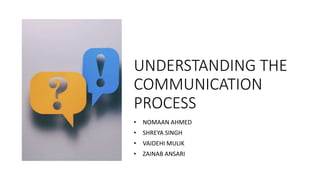
Group 2 Communication Process.............
- 1. UNDERSTANDING THE COMMUNICATION PROCESS • NOMAAN AHMED • SHREYA SINGH • VAIDEHI MULIK • ZAINAB ANSARI
- 2. CONTENT DEFINITION KEY COMPONENTS CLASSIFICATION MODELS PROBLEMS WAYS TO OVERCOME THOSE PROBLEMS CONCLUSION
- 3. COMMUNICATION PROCESS Communication is the structured sharing of information between a sender and receiver. It involves encoding a message, transmitting it through a chosen channel, and decoding it for understanding. Success hinges on accurate encoding, effective transmission, and shared comprehension.
- 4. KEY COMPONENTS Sender: The process begins with a sender, one who wants to convey the message. Message: The message is the information, idea, or emotion that the sender wishes to communicate. It can be verbal, written, or non-verbal. Encoding: Encoding involves converting the message into a suitable form for transmission, such as choosing words, creating visuals, or using symbols. Channel: The channel is the medium through which the message is transmitted. Receiver: The receiver is the individual or group for whom the message is intended. They play a crucial role in the communication process by interpreting the message
- 5. KEY COMPONENTS Decoding: Upon receiving the message, the receiver decodes or interprets it. Decoding involves understanding the symbols, words, or visuals used by the sender. Feedback: Feedback is the response from the receiver to the sender. It indicates whether the message was understood and provides an opportunity for clarification or further communication. Noise: Noise refers to any interference or distortion that can affect the clarity of the message during transmission. Context: The context refers to the surrounding circumstances or environment in which the communication takes place. Barriers: Barriers are obstacles that can impede effective communication.
- 6. Classification of Communication Based on Direction: Upward Communication: Flow of information from lower levels of an organization to higher levels. Downward Communication: Flow of information from higher levels to lower levels. Horizontal Communication: Communication that occurs between individuals or departments at the same hierarchical level. Based on Nature: Formal Communication: Official, planned communication within an organization. Informal Communication: Unofficial, spontaneous communication that may not follow established channels. Based on Media: Verbal Communication: Involves spoken or written words. Non-verbal Communication: Involves gestures, body language, facial expressions, and visual elements. Written Communication: Involves the use of written words.
- 7. Classification of Communication Based on Purpose: Internal Communication: Communication within the organization. External Communication: Communication with entities outside the organization. Based on Technology: Traditional Communication: Involves conventional means like face-to-face conversations, letters, or printed materials. Digital Communication: Involves electronic means such as emails, video calls, instant messaging, or social media.
- 9. SHANNON-WEAVER MODEL Also known as the linear model, this communication model was developed by Claude Shannon and Warren Weaver in 1949. It depicts communication as a one-way process with seven key elements: • Sender: The originator of the message. • Encoder: The sender converts the message into a suitable form for transmission. • Message: The information or content being communicated. • Channel: The medium through which the message is transmitted (e.g., airwaves, cables, or printed materials). • Decoder: The receiver who interprets and decodes the message. • Receiver: The destination of the message. • Noise: Any interference or disturbance that can disrupt the communication process. The model suggests that communication is a linear process where the sender sends a message through a channel to the receiver, and noise can affect the clarity of the message.
- 10. TRANSACTIONAL MODEL The transactional model of communication, proposed by Barnlund in 1970, recognizes communication as a dynamic and interactive process. It emphasizes the simultaneous roles of both the sender and receiver, and communication is seen as an ongoing, circular exchange. Key elements include: • Sender: Initiates the communication process. • Message: The information being communicated. • Channel: The medium through which the communication occurs. • Receiver: Interprets and responds to the message. • Feedback: The response from the receiver, providing information on how the message was received. • Context: The situational and cultural factors that influence the communication. In this model, communication is not a one-way street but rather a continuous, reciprocal interaction between sender and receiver. Both parties play active roles, and the feedback loop allows for adjustments and clarifications. These models provide frameworks for understanding the different elements and dynamics involved in communication. The Shannon-Weaver model emphasizes the linear nature of communication, while the transactional model highlights the dynamic and interactive aspects, acknowledging the ongoing nature of the communication
- 11. PROBLEMS IN COMMUNICATION NOISE BARRIER INCONSISTENCY LACK OF CLARITY INFORMATION OVERLOAD EMOTIONAL DISTURBANCE TECHNOLOGICAL ISSUES CREDIBILITY ISSUES SELECTIVE PERCEPTION LACK OF FEEDBACK
- 12. PROBLEMS • NOISE: Any Interference that disrupts the communication process. • BARRIERS: Obstacles that impede the flow of communication. • INCONSISTENCY: Lack of Coherence and consistency in messages. • LACK OF CLARITY: Messages that are unclear or ambiguous. • INFORMATION OVERLOAD: Being Overwhelmed with too much information. • EMOTIONAL DISTURBANCE: Emotional States affecting communication.
- 13. PROBLEMS • TECHNOLOGICAL ISSUES: Problems related to communication tools and technology. • CREDIBILTY ISSUES: Lack of trust or credibility in the communicator. • SELECTIVE PERSECPTION: Individuals interpreting messages based on their own beliefs or preferences. • LACK OF FEEDBACK: Absence of responses/feedback from the receiver.
- 14. CONCLUSION In essence, effective communication is a nuanced dance between senders and receivers, demanding clarity and adaptability. The models explored, from Shannon-Weaver's linearity to Barnlund's interaction, underscore the complexity of this vital process. In our interconnected world, the ability to navigate communication challenges is not just a skill but a key to fostering meaningful connections and shared understanding.
- 15. THANK YOU